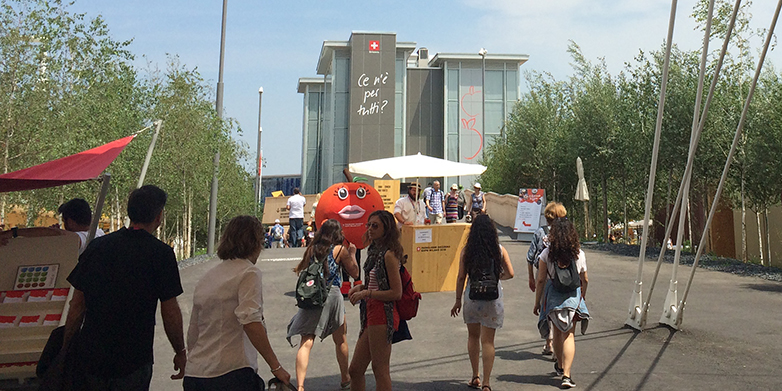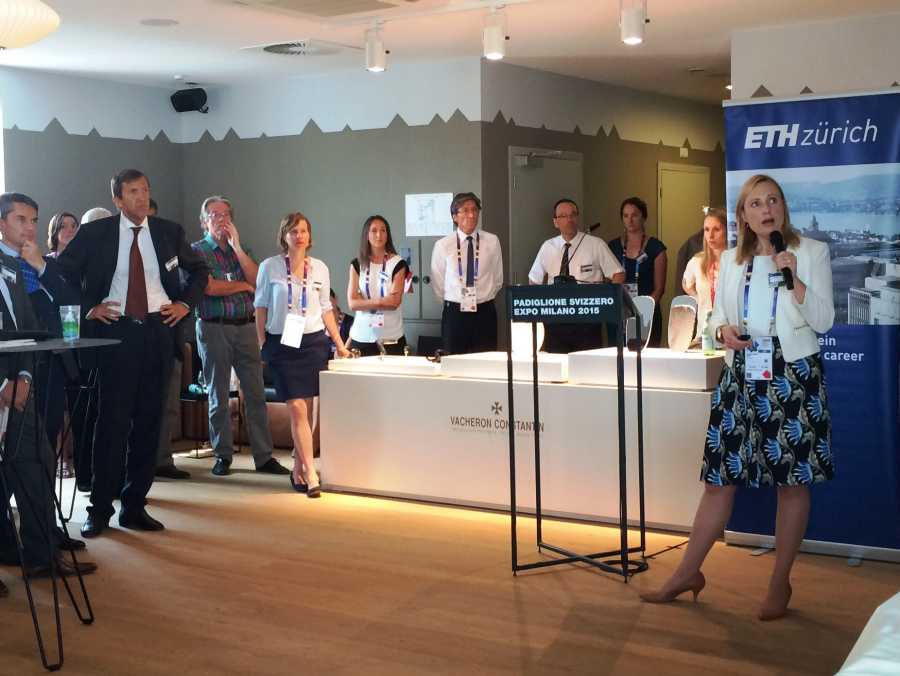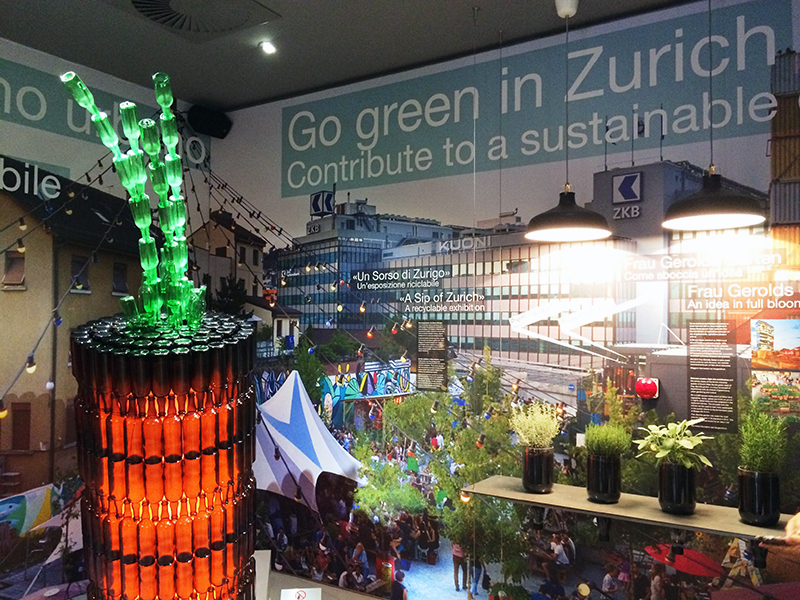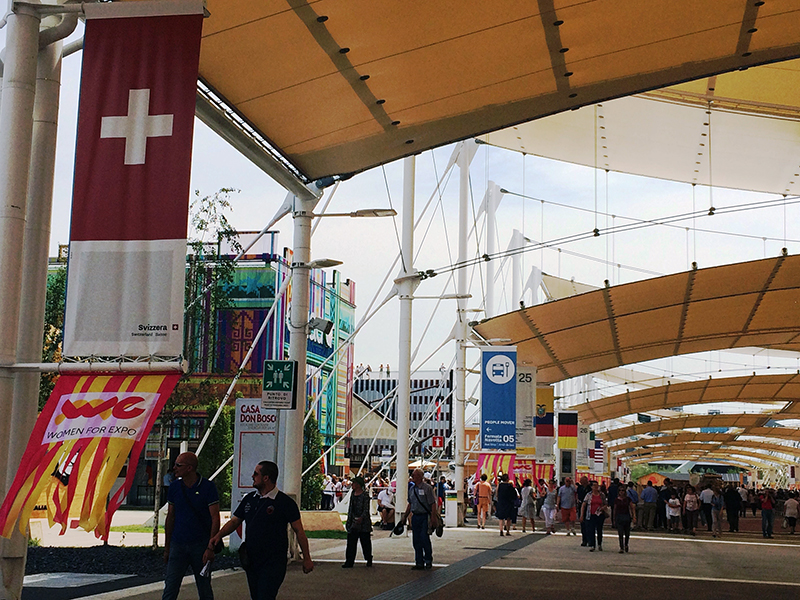Science on your plate
ETH Zurich researchers enlightened guests about the food value chain and the science behind what was served on their plates during the opening ceremony of Zurich week in the Swiss Pavilion at Expo Milano 2015 last Monday.
Take a good look at your dinner plate this evening and consider the fact that decades of science have gone into the production of the food on your plate. This is what guests were invited to do during "Science on Your Plate," the opening ceremony of Zurich Week in the Swiss Pavilion at Expo Milano 2015. ETH Zurich and the World Food System Center hosted the evening as a tribute to the Expo's theme, "Feeding the Planet, Energy for Life".
Lino Guzzella, president of ETH Zurich, welcomed the guests with sincere opening remarks, “I am delighted that ETH Zurich has joined Presence Switzerland, the City and Canton of Zurich, as well as other key partners in representing Switzerland at Expo Milano. As a university with a highly international orientation, our researchers and educators genuinely care about the issues represented here – food is one of the defining problems of this planet. We are taking a multi-disciplinary approach at ETH to address food security and renewable water resources. The Expo provides us with a platform where knowledge and ideas converge to inspire change.”
After the welcome address, the hosts served guests different delicacies. While they were eating, ETH Zurich scientists offered insights into the production of the food served and how sustainability issues relate to agriculture. Some of the highlights of the evening included presentations on cheese, rice and honey.
The real value of dairy
Valeria Galetti, a post-doctoral researcher at ETH Zurich's Institute of Food, Nutrition and Health began the evening by saying, “When we think of the nutritional value of dairy products like cheese, our first thoughts are calcium and protein, but the real value of dairy in the human diet is iodine.” Galetti is about to begin work with a doctoral student on a two-year study of iodine levels in Swiss cows, their dairy products, and the Swiss population. She asserted during her presentation that dairy products are the most important contributors of dietary iodine for the Swiss population.
Galetti demonstrated data that indicates iodine levels in Swiss milk are inconsistent throughout the year. In the winter months, when cattle receive nutritional supplements, iodine levels are higher than in the summer when Swiss cows graze in the high alpine meadows.
Galetti seeks to better understand this phenomenon and eventually recommend measures to mitigate the seasonable variability of iodine in milk as well as the losses resulting from production processes. She will also conduct a clinical trial to measure human absorption of iodine and anticipates that the applied research could benefit production processes, making dairy products a stable, reliable source of iodine in the western diet.
How rice can harm the environment
As the risotto dish was served to Expo guests, Charlotte Decock, environmental systems science lecturer and part of ETH Zurich's Sustainable Agroecosystems Group, reported on rice, a staple food for more than half of the world’s population. Rice crops are grown on every continent in the world except Antarctica, and thus in widely varying circumstances: on steep mountain terraces, in coastal areas subject to salt-water contamination, and on vast irrigated plains. Rice production not only consumes local water resources, it is also an important contributor to greenhouse gas emissions, as the microorganisms living in the anaerobic soil conditions of irrigated rice fields produce methane gas.
Through their collaboration with the Italian national rice agency (Ente Nazionale Risi) and other partners, Decock’s team addresses the water and methane challenges of growing rice by studying the biogeochemistry of the soil in response to alternative water management. Sequential flooding and draining of the rice fields helps to conserve water resources and reduce the conditions that create methane gas emissions.
Honey and pollination management
Antoine Champetier de Ribes, who also lectures in the Department of Environmental Systems Science in the Agricultural Economics Group, presented a bio-economic perspective on honey production. “Think of honey as a payment that crops and wildflowers exchange for the pollination services of honeybees,” he said.
Using data from the Food and Agricultural Organization of the United Nations, he explained to his audience that the number of beehives has increased by 30 million in the past 50 years. One of the key economic drivers is the relative price of honey to the opportunity cost of agricultural labour. Champetier de Ribes also identified a demand for pollination services as another driver. In California, for example, almond production involves the collaboration of beekeepers in a mass managed pollination event that accounts for almost half of the beekeeping revenues in the United States.
Corine Mauch, mayor of the City of Zurich, offered her final thoughts on a great evening and a fruitful collaboration, “The Zurich week exemplifies what our city has to offer when it comes to research, creativity, culture, innovation, quality of life and sustainability. As a city, we can create a platform for these issues at the Expo. For the content we have to rely on competent partners. The cooperation with ETH Zurich was for us, a ‘perfect match’ and of very high importance. I very much appreciate the commitment of the ETH".
Videos
Visitors to the Swiss Pavilion during Expo Milano 2015 can view the ETH Zurich film contribution “Water – The Source of Life” that portrays the research the university is conducting into water and food security. DrinkPure, a product that filters contaminated water from ETH Zurich spinoff company external page Novamem, is also exhibited.






Comments
No comments yet